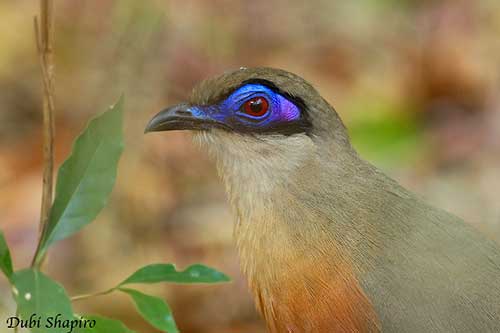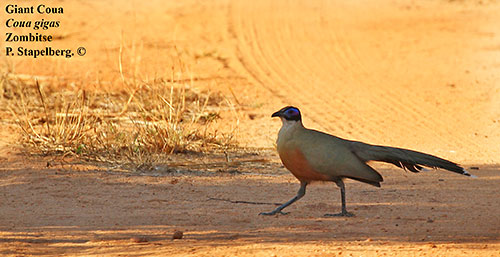
Fr: Coua géant
Ang: Giant Coua
All: Riesen-Seidenkuckuck
Esp: Cúa Gigante
Ita: Cua gigante
Nd: Grote Coua
Sd: jättekoua
Mal: Eoke, Gory be, Lejabe
Photographers:
John Anderson
John Anderson Photo Galleries
Dubi Shapiro
Dubi Shapiro Photo Galleries
Philip Stapelberg
GALLERY
Text by Nicole Bouglouan
Sources:
HANDBOOK OF THE BIRDS OF THE WORLD vol 4 by Josep del Hoyo-Andrew Elliott-Jordi Sargatal - Lynx Edicions - ISBN: 8487334229
Birds of Madagascar and the Indian Ocean Islands Par Roger Safford, Adrian Skerrett, Frank Hawkins – ISBN: 1472924118, 9781472924117- Editeur: Bloomsbury Publishing, 2015
Cuckoos of the World Par Johannes Erritzøe, Clive F. Mann, Frederik Brammer, Richard A. Fuller – Editeurs A&C Black, 2012 – ISBN: 1408142678, 9781408142677
Wildlife of Madagascar par Ken Behrens,Keith Barnes - ISBN: 140088067X, 9781400880676 – Editeur: Princeton University Press, 2016
The Cuckoos Par Robert B. Payne – Editeur : OUP Oxford, 2005 – ISBN : 0191513555, 9780191513558
The Birds of Africa: Volume VIII: The Malagasy Region: Madagascar, Seychelles, Comoros, Mascarenes - Par Roger Safford, Frank Hawkins – ISBN: 1408190494, 9781408190494- Editeur: A&C Black, 2013
Wikipedia, the free encyclopaedia
CREAGUS - CUCKOOS & ALLIES - Cuculidae
Giant Coua
Coua gigas
Cuculiformes Order – Cuculidae Family
INTRODUCTION:
The Giant Coua is endemic to Madagascar. It occurs in S and W, mainly in deciduous forests and other drier habitat types.
This secretive bird is mainly terrestrial and seldom flies, preferring to run quickly if flushed. It forages on the ground where it searches for insects, reptiles and seeds. This species is not a nest-parasite. It builds its own nest, incubates the eggs and rears its chicks.
The Giant Coua is not globally threatened because the continuous degradation of the habitats creates new suitable areas for this species.
DESCRIPTION OF THE BIRD:
Biometrics:
Length: 58-62 cm with the long tail of 28-31 cm
Weight: 415 g
The Giant Coua adult has olive-grey with dull bronze sheen upperparts including nape, back and wings. The uppertail-coverts are darker. The tail is glossy dark bronze with white tips, except on central rectrices.
On the underparts, chin, throat and upper breast are creamy-white, but lower breast, upper belly and upper flanks are deep cinnamon-brown. Lower belly and rear flanks are blackish-brown but the undertail-coverts are black.

On the head, forehead, crown and nape are dark olive-brown. We can see a conspicuous area of bare skin, blue around the eye and on lores, and pink behind the eye. This area is outlined with black.
The bill is black. The eyes are dark brown to red-brown. Legs and feet are black.
Male and female are similar.
The juvenile is duller than adults. Wing-coverts and scapulars are olive-grey with pale spots. Belly and flanks are barred buff and dark brown. The tail is duller too. The bare area around the eye is dull blue and the bill is pale horn.
RANGE:
The Giant Coua is found in S and W Madagascar, N to Betsiboka River.
HABITAT:
The Giant Coua is present in the coastal lowlands of S and W, in deciduous forest, gallery forest, forested areas and brush on sand, sub desert, sub arid thorn scrub on calcium-rich soil, and among large trees with grass or little understorey. This species is visible from sea-level up to 800 metres of elevation.
REPRODUCTION OF THIS SPECIES:
The Giant Coua builds the nest from late October to December, and the laying occurs in November/December. The chicks can be seen in January.
Both adults build a bowl-shaped nest in tree (Acacia or Tamarindus), between 3 and 10 metres above the ground. It is made with twigs, bark and large leaves and lined inside with leaf petioles. The nest is built among vines and lianas, and woven around branches in dense vegetation.
During the nest-building, both mates are very secretive. If disturbed, they wait for long periods before to return to the nest-site. They build a new nest at some distance if the first one is destroyed.
The female lays 3 dull white eggs. Incubation and nestling periods are unknown.
PROTECTION / THREATS / STATUS:
The Giant Coua is affected by trapping and hunting in S of range. However, it is very common in protected areas such as Berenty Private Reserve.
The species is fairly common where the forest still exists, and more in relatively undisturbed forest than in forest habitat degraded by fire or logging. It is more common in W Madagascar.
The population is suspected to be increasing with creation of new suitable habitats following degradation or destruction.
The Giant Coua is currently evaluated as Least Concern.
CALLS AND SONGS: SOUNDS BY XENO-CANTO
The Giant Coua usually calls from the ground or from low perch. It gives a deep “wok wok wok…” followed by loud, guttural “ayoo-ew”. It also gives resonant “kookookookookoogogo” with lower two last notes. We can also hear short grunts.
BEHAVIOUR IN THE WILD:
The Giant Coua feeds primarily on insects such as Coleopteran, Blattodea, Hemipteran and ants. It also takes some reptiles and consumes seeds.
It forages quietly by walking on the ground with raised head and horizontal tail. It searches for prey on the forest floor among the leaf litter. It runs quickly while pursuing a prey, and leaps up in the air to catch a flying insect.
It is often seen singly, in pairs or in small family groups. It rests on low branches and sunbathes on the ground with ruffled feathers and dropped wings.
The Giant Coua is very vocal during the breeding season, included sometimes at night, but usually in the early morning.
Most of the nesting Cuculidae are socially monogamous and both adults raise the chicks. The courtship displays are unknown, but we can suggest that the bright-coloured head pattern is enhanced by adapted postures, and the long tail is probably fanned. It is a non-parasitic species.
The Giant Coua is resident on the island.
It prefers to run quickly or to climb onto a tree branch to escape a danger rather than to fly. It rarely flies and only over sort distances.
